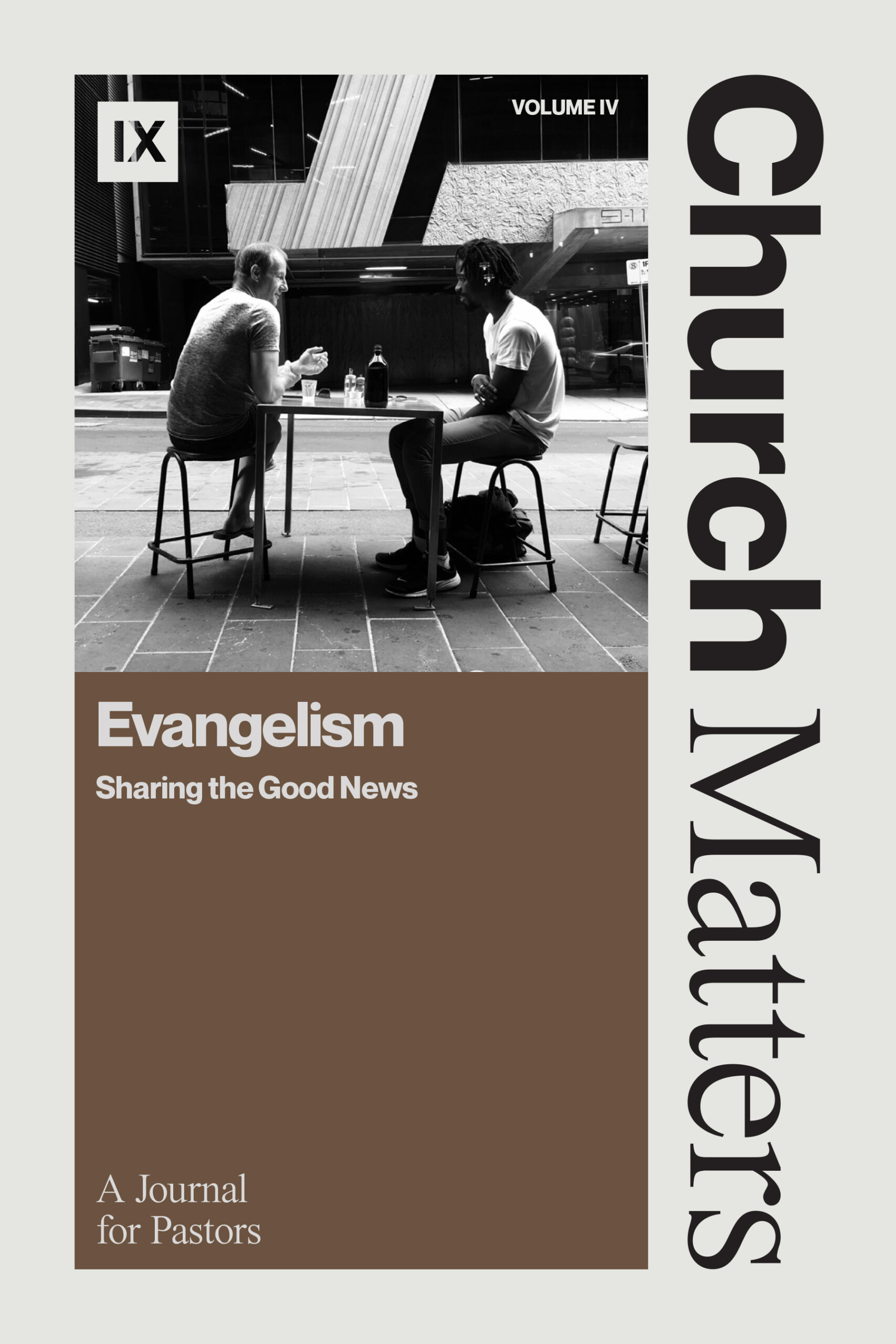Evangelism as a Community Project
Listen to these words from church member Brittany, which she shared during her baptismal testimony: “Since being at this church, attending service, new member classes, getting questions answered by Joel and Eric, and interacting with all of you, my understanding of the gospel has been maximized.”
My heart was especially warmed when she referred to “interacting with all of you.”
Brittany wasn’t alone in noting the community aspect of coming to faith. Many others have referenced the same in their baptismal testimonies. In fact, few people have referenced just one person in their testimonies. Most cite multiple names, and this thrills me.
Personal evangelism should not look like lone-ranger Christianity. Too often, evangelicals separate their relationship with their church from their efforts to share the gospel with lost people. Some Christians are even afraid to invite those they are evangelizing to church. This may be because Christians are afraid of generational, ethnic, cultural, or demographic differences. It may also be because they have an overinflated view of their personal evangelism and an underinflated view of the church’s ability to help.
Friend, your fellow church members are assets to your evangelism. Regardless of how different the Christians in your church are from the people you’re sharing the gospel with, it’s your relationship with your church and all the members’ relationships with each other that will put the gospel on display for the lost. Remember, the power of the gospel is not in the swagger of the Christian. It’s in the gospel message itself and the new community it creates.
Evangelism as a Community Project in the New Testament
In the early church, evangelism was often done in community. Timothy was led to Christ by the dynamic duo formed by his mother and grandmother. In Philippi, Lydia’s heart was opened through Paul’s preaching, but Paul wasn’t alone. Paul’s crew included Silas, Timothy, Dr. Luke, and others as well (Acts 16:1–15). Both Priscilla and Aquila shared in the work of explaining the faith to Apollos (Acts 18:24–26).
These kinds of community efforts are precisely what Jesus envisioned when he taught that non-Christians would understand something of the gospel by the way they saw Christians loving one another (John 13:34–35). Christian love that is compelling and countercultural actually displays supernatural realities. So when we build our lives around the church, live in transparency with fellow believers, practice hospitality and service for one another, weep with the weeping and rejoice with the rejoicing, we say something about what Jesus has done for us.
Everything from game nights to cookouts, from prayer meetings to neighborhood walks, are opportunities to love and so advocate for the gospel in front of the watching world.
This is why we should invite our non-Christian friends to witness the love we enjoy in our churches. Divorcing one’s evangelistic work from the church misses this powerful testimony of Christ’s love. If I consider my neighbor my own evangelism project, and not a community project, I lose the attractive force of Christian community.
You may be thinking, “Isn’t church only for Christians?” Yes and no. The church is fundamentally made up of only those who have repented of their sin and received Christ. However, even the apostle Paul assumes non-Christians will attend Sunday morning gatherings. This is why he instructed the church in Corinth to organize their services and speak in such a way that makes sense to the outsider (1 Cor. 14:23). The apostle envisions unbelievers confessing that “God is really among them” as the Word of God prophetically speaks through their gathering (1 Cor. 14:25).
The How-to’s of Evangelism in Community?
But how do churches organize and speak to the end that non-Christians may say something like “God really is among them” after having attended a service?
Introduce Your Non-Christian Friends to Your Church Friends
While evangelists (any Christian sharing the gospel) should share the whole gospel with unbelievers, they also do well to consider themselves as initiators. That is, they should connect other Christians to the one they are sharing the gospel with. After all, evangelism is often best done on a team.
Consider Creative Strategies and Don’t Discount an Invitation to Church
I’m often surprised when people accept my invitation to attend a church service. Granted, most graciously turn down my offer, but sometimes they show up, as happened this past Sunday. I immediately took the opportunity to introduce my unbelieving friend to someone else in church. From there, I watched as my brother in Christ engaged in conversation with my unbelieving friend! What joy that was to me!
Involve Non-Christians in Other Activities with Fellow Church Members
In addition to regular gatherings, we should consider making it a habit to invite unbelievers to social gatherings with church members. This may include basketball games on the playground or working out with a few other church members. Find out which restaurants and establishments your fellow church members frequent and join them, share names of employees with each other, and begin praying for the lost. Consider living in the same neighborhood with other church members, ideally near your church. This creates a natural gospel-network of neighbors bumping into each other, hosting block parties, and neighborhood events all of which directly or indirectly can point to the gospel. God has given many favorable circumstances. Most of the time, we’re sitting in the middle of opportunity, we just don’t know it.
As your non–Christian friend begins engaging with church members, he or she will hear others reinforce things you’ve said, and sometimes in better ways. A sister will offer an insight you never saw. A brother may explain a truth you were struggling to communicate. Sharing our evangelistic relationships is humbling. But evangelism is not about us getting the credit. It’s always the Lord who converts. We don’t baptize them into us, but into the church.
What I’m Not Saying
I am not advocating for what is referred to as “center-set evangelism” versus “boundary-set evangelism.” Some missiologists have argued for center-set evangelism, claiming that boundaries like church membership actually harm evangelism. They assert that we should point unbelievers to the center of the faith—the way of Christ—regardless of other doctrinal differences or formal commitments. Center-set evangelism tells unbelievers they can “belong, before they believe.” This view misses the countercultural beauty of the boundaries.
“Belonging before believing” is incongruent with the way of salvation and the formation of the church through the Holy Spirit. Only through Christ’s blood applied to the sinner, the filling of God’s Spirit, and the response of faith can a sinner be included in the family of God. This inclusion is signified by the ordinance of baptism.
Boundaries not only matter, but they strengthen the attractive force of the church. The defined community of saints creates a family dynamic that visibly displays holiness and loves the lost. Clarity matters. A community framed by right doctrine, church membership, and church discipline displays the glory of Jesus.
A Few Stories of Evangelism in a Community
After sharing the gospel for months, David considered his neighbor his personal evangelistic connection. David hired his neighbor to mow his lawn and invited him over to dinner several times. One day, David realized he could share this relationship with other church members. Immediately, he introduced his neighbor to his church friends as a potential hire for their lawn service. These members not only began hiring David’s neighbor to cut grass, they also began sharing the evangelistic load. Who knew helping someone grow their lawn business could be part of a team’s evangelistic strategy!
Ashley temporarily lived with church members who had been wanting to share Christ with Amber, their neighbor two doors down. When Ashley discovered Amber owned a hair salon, she began to go to Amber for her hair. She also encouraged other ladies from church to do the same and to share the gospel with Amber. While Amber has yet to trust Jesus, she is now friends with a network of church ladies who desire to reach her.
Kareem met a Christian named Joe at his workplace. Joe met with Kareem for lunch once a week to talk about the gospel. Over time, Joe introduced Kareem to five Christian families who lived in Kareem’s neighborhood and went to church nearby. After two years of resisting the gospel, Kareem hit rock bottom and lost his home. For the next year, he lived with almost all of the neighborhood church families. He bounced from one home to the next. During this time, he watched fathers pray with their kids, participated in family worship, and had plenty of meaningful conversations about faith and life. Eventually, Kareem was converted through the neighborhood network of church families who opened their homes and lives to him. While Joe initiated the work with Kareem, he was not the sole evangelist. He may not have even been the most important part of the story. It was a communal work, and everyone got to share in Kareem’s conversion story.
Conclusion
What are takeaway lessons?
Seek to become a great personal evangelist. Along the way, introduce your unbelieving friends to your fellow church members. Learn of your brothers’ and sisters’ evangelism endeavors and help them in whatever ways you can. Pray that God would cause them to respond to the gospel. Embrace the teamwork of gospel ministry.
Evangelism is a community project.









